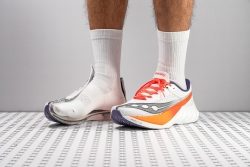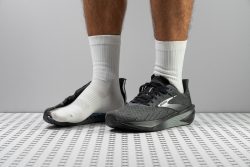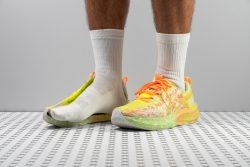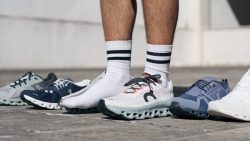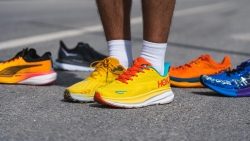7 Best HYROX Running Shoes in 2025
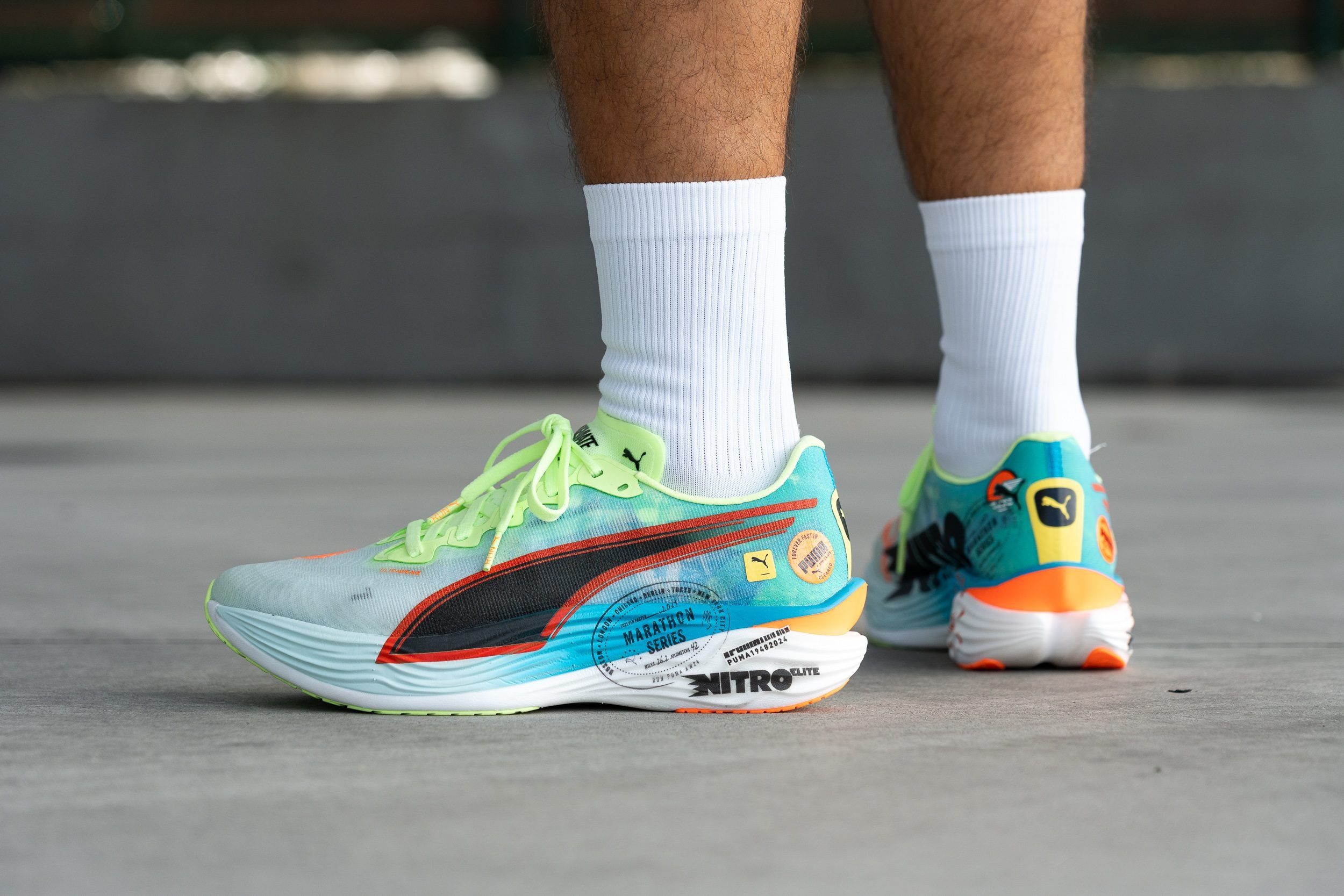
We buy shoes ourselves. We earn commissions when you buy through us, at no extra cost. Why trust us
The popularity of HYROX has grown explosively post-pandemic, and its participation rates are quickly catching up with Crossfit. However, there are still no clear-cut criteria for what makes the best HYROX shoes, and people end up using whatever athletic footwear is at their disposal.
Given the 8 km running distance involved in this competition, participants often turn to their trusty running shoes for the job. But are all running shoes up for the task?
Having thoroughly tested hundreds of pairs, we came up with the best options for HYROX specifically. You can also learn about all the nuances of selecting the right shoe in our in-depth guide below.
How we test HYROX running shoes
In addition to running, rowing, lunging, and sled pushing in each tested shoe, we also take them through a series of lab tests to get over 30+ data points for a more comprehensive picture.
We use specialized tools and machinery to measure parameters like forefoot traction, energy return, midsole dimensions, stack height, drop, and weight, among others. These characteristics are essential for peak performance in HYROX, and having objective data allows us to shortlist the truly best options for the sport.
What’s more, none of our lab tests are sponsored – we buy all the tested shoes ourselves.
Best HYROX shoes overall
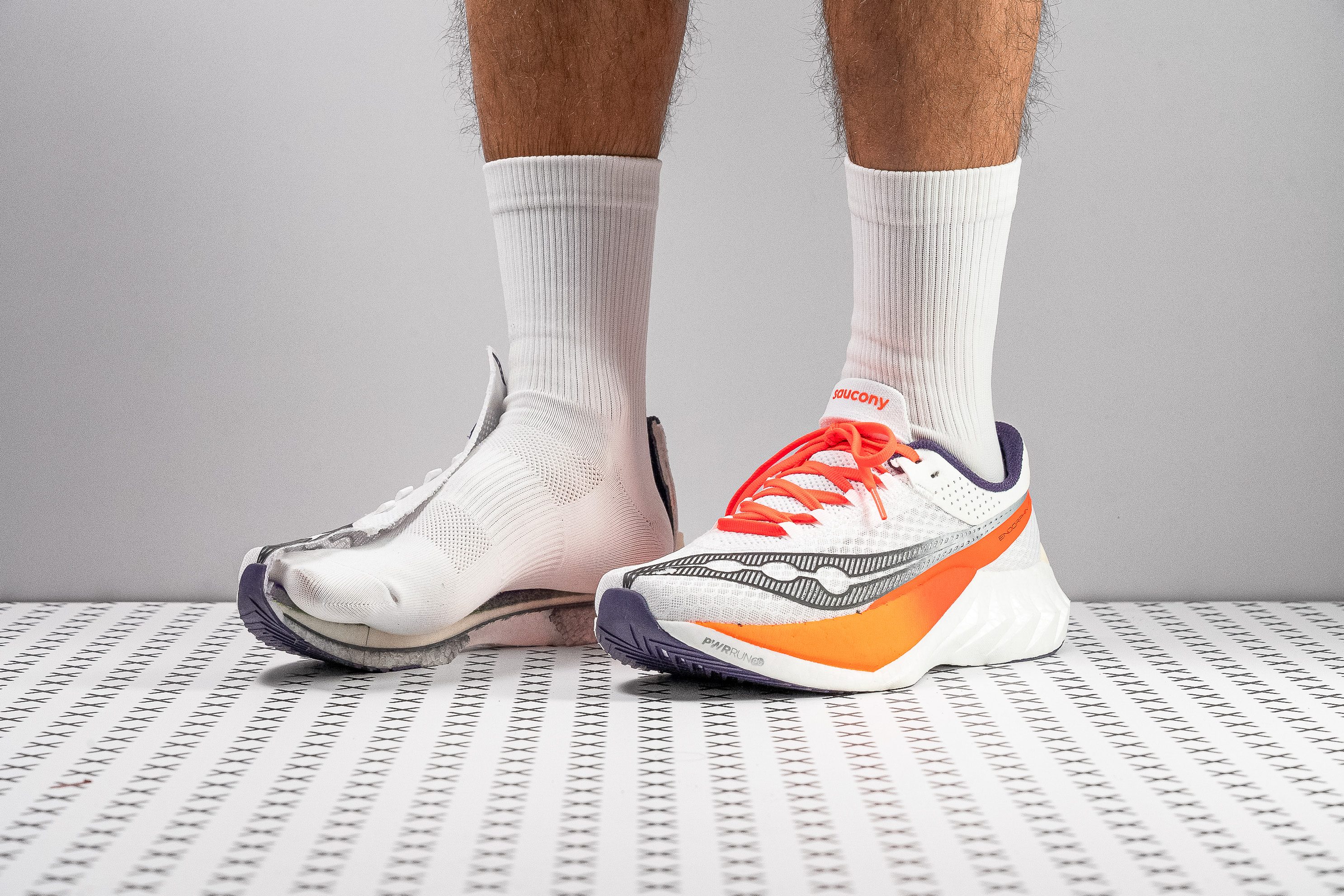
























































What makes it the best?
The Saucony Endorphin Pro 4 is a powerhouse that generates speed and smooth forward motion in a lightweight package during our runs. Digging deeper in the lab, we confirmed the cushioning's exceptional impact protection and its undeniable stability through its carbon plate, boosting comfort and support for our workouts. No doubt, it’s our top HYROX running shoe.
The midsole feels highly energetic, and our lab tests confirm our observation with a 71.7% energy return rating, 23.4% greater than average. This helps us make efficient use of the power we exert during runs, while the cushioning absorbs impact to protect our muscles. We validated in the lab that the midsole shock absorption is 9.4% better than average.
Another feature that enhances EP4’s comfort and speed is its airy 7.8 oz (220g) weight, 17.0% below average! Having lighter shoes puts less load on our legs and allows us to complete each exercise with less effort.
We also discovered an S-shaped carbon plate, which generates smooth forward transitions through its Speedroll technology. In addition, its stiffness enhances our alignment and prevents ankle twists, improving our stability. Our manual assessment backs us up with a high 4/5 torsional rigidity rating.
Unfortunately, longitudinal flexibility is compromised, which means more work is needed in foot-bending movements like lunges. Those who prefer more natural movement should find a more flexible pair.
Pros
- Durable upper and outsole
- Spacious upper fit
- Enhanced midsole comfort
- Great value at $225 for a supershoe
- Versatile across all paces
- Ideal for heel strikers
- More stable than ever
Cons
- Slightly heavier than v3
- Less suited for forefoot strikers
- Competitors may feel quicker
HYROX shoes with the best traction






























































What makes it the best?
The PUMA Deviate Nitro Elite 3 feels electric with each takeoff, thanks to its light and springy midsole, followed by well-cushioned landings care of its dreamy cushioning we verified in the lab. Yet what makes it stand out the most is its sticky PumaGrip rubber, giving us the best grip we could find in HYROX running shoes.
Even as we worked through sweaty gym floors, each movement felt steady and controlled thanks to the PumaGrip rubber of the DNE 3. We tested it under wet conditions using our machine and earned an impressive 0.67 score, making it a whopping 42.6% grippier than average!
Running at top speed felt more natural in the DNE 3 because of its lively midsole, which our lab tests confirm with a mind-blowing 77.1% energy return, 31.8% greater than average. Our solid takeoffs are complemented by soft landings, validated by the cushion’s impressive 147 SA score in our shock absorption test.
The shoe feels airy on foot, and our scales confirm it’s only 7.2 oz (204g). Being 23.0% lighter than average, it takes less work to accomplish both the runs and other exercises, such as burpees.
At $230, we believe DNE 3 is worth the price for athletes who really want to shave seconds off their time. However, those who are not willing to take the steep investment can go for a lower-priced alternative.
Pros
- Superb Nitro Elite foam
- Breathable, lightweight upper
- Extremely responsive
- More affordable than most supershoes
- Outstanding grip
- Great comfort for a racer
- Major improvements from v2
- Fast, agile, race-ready performance
- Fantastic tongue
Cons
- Not the best for heel strikers
- Durability concerns
- Lacks stability for some runners
HYROX shoes with the best energy return














































What makes it the best?
Running plays a major role in HYROX, and we believe the Saucony Endorphin Speed 5 allowed us to smash the 1-km portions by offering the best energy return among HYROX running shoes. In the lab, we discovered it features the top-level PWRRUN PB foam, which explains its responsiveness, comfort, and lightness. Meanwhile, its nylon plate and SPEEDROLL geometry create smooth yet centered strides.
Even with its thick 37.4/26.8 mm stack, ES5 remains lightweight at 8.5 oz (241g), 9.1% below average. Its lightness is further enhanced because the midsole is packed with bounce, verified by its high energy return scores of 73.2% in the heel and 78.2% in the forefoot.
Complementing powerful toe-offs are plush landings, care of the shoe’s high shock absorption, which we verified in the lab. The heel returned 132 SA and the forefoot 108 SA, both comfortably exceeding their respective averages, which means the midsole offers superior impact protection.
The nylon plate and SPEEDROLL technology promote effortless forward movement and enhance stability. Lab tests show that torsionally, the base offers resistance with its 4/5 rating, but longitudinally, it’s 14.6% more pliable than average. This creates a well-planted yet versatile ride.
It’s hard not to love this shoe, and the only test it failed was the toebox durability test. Those who want a sturdier upper should go for another shoe.
Pros
- Supershoe-like energy return
- Fantastic upper with top-notch ventilation
- Softer PWRRUN PB foam
- Endorphin Speed DNA still present
- Great lockdown
- Versatile for multiple paces
- Smooth SPEEDROLL rocker
- Roomier and taller toebox
- Can be used for racing too
- OG special colorway looks fantastic!
Cons
- Small price hike
- Less agile than predecessors
- Durability downgrade
HYROX shoes with the best stability
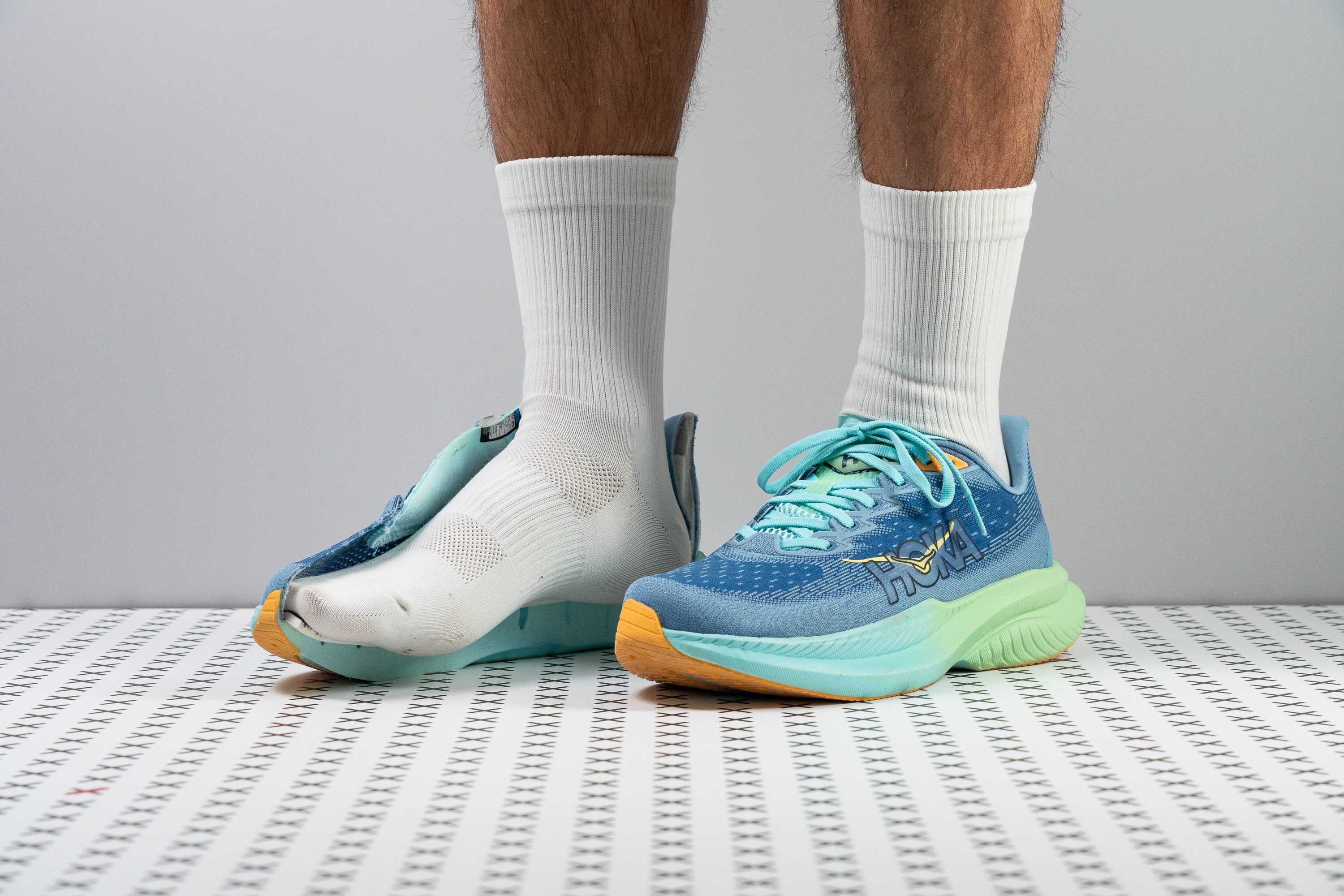





















































What makes it the best?
Among HYROX running shoes we tested inside the gym and our lab, the Hoka Mach 6 stands out for its stability. It’s an all-rounder that offers structure for lateral movements, responsiveness for runs, and flexibility for other foot-bending exercises.
We didn’t expect much from its narrow midsole and plush cushioning, but the Mach 6 feels exceptionally stable. It’s highly resistant to twisting, which kept our feet centered and secured. In our manual twist test, we confirmed its rigidity with a high 4/5 rating.
Thankfully, that's not the case when bending our feet. In our bend test, it emerged 9.9% more flexible than average, allowing us to perform other exercises such as sled pushes and burpees with less effort.
When it was time for our 1-km segments, the midsole came alive with its snappy rebound. Testing for energy return, the Mach 6 understood the assignment and recorded high scores of 65.4% in the heel and 67.0% in the forefoot.
Unfortunately, its tapered toebox limits room for natural toe splaying. Athletes seeking an accommodating shoe should test other options.
Pros
- Really lightweight
- Fantastic outsole
- Exciting ride
- Highly cushioned
- Great for heel strikers
- Handles faster paces
- Superb lockdown
- Excellent value at $140
Cons
- Drop varies from stated
- Tapered toebox
- Thin tongue
Best lightweight HYROX shoes
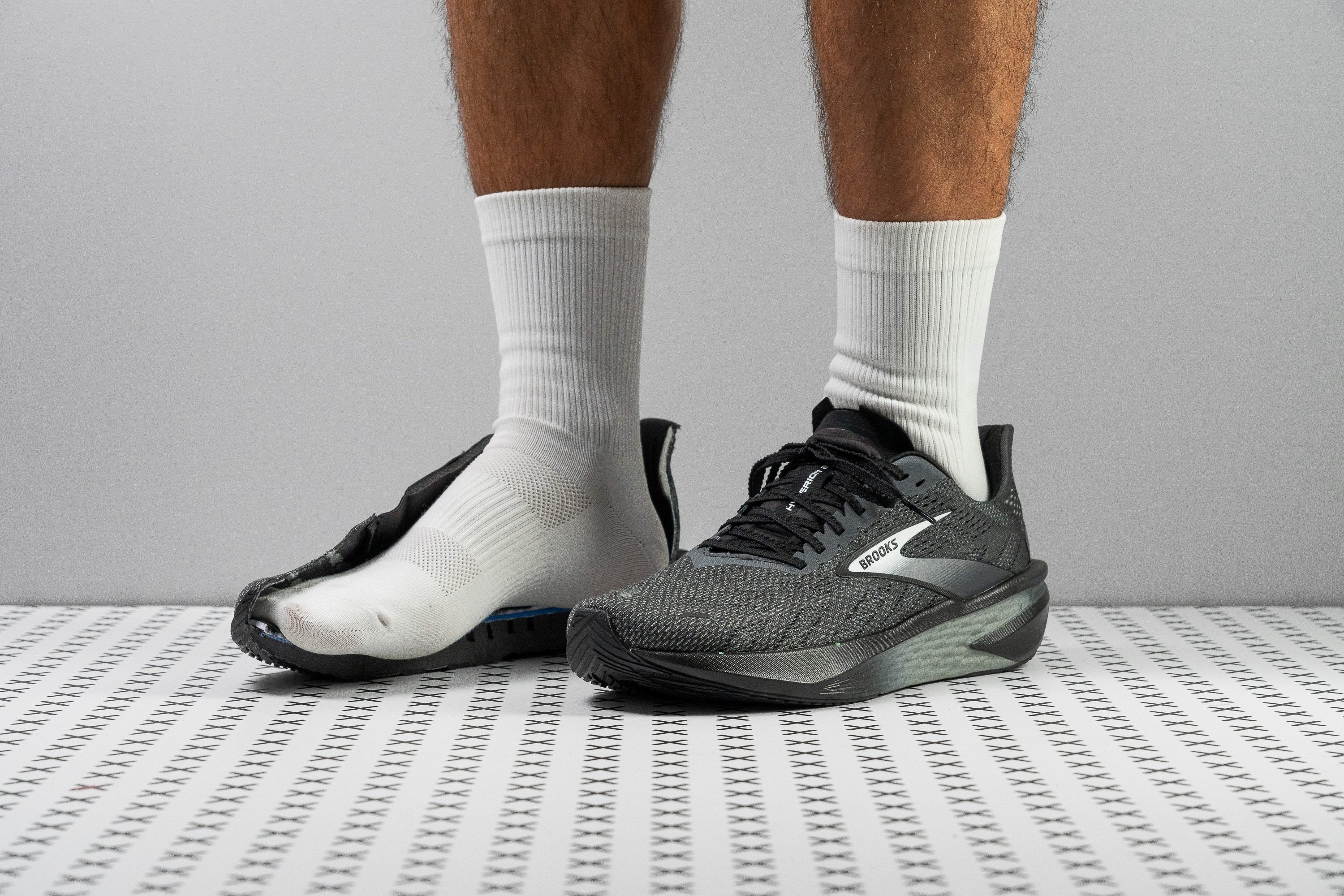



















































What makes it the best?
With its feathery build, the Brooks Hyperion 2 eased the burden of multiple exercises and 1-km run segments. Among HYROX running shoes, it gave us the best lightweight experience. Besides its low weight, lab tests show its maximum ventilation and flexible build further enhancing the weightless experience.
We knew the shoe was airy, but its low 7.2 oz (203g) figure still blew us away. Compared to the average, it offers 23.4% significant weight savings and reduces leg fatigue.
Its lightness is further enhanced by its very forgiving midsole. With a low 13.0N flexibility score in our bend test, it flows with our feet and can adapt to various movements like burpees and sled pushes. It takes 13.9% less effort to bend the Hyperion 2 compared to the average.
Comfort is taken to the next level with its breathable upper. With free airflow, we never encountered heat or sweat build-up. In our smoke test, the air flowed out seamlessly, earning the maximum 5/5 breathability score.
However, what it lacks is a stable and controlled feel. Those in need of more support should skip this pair since it demands proper form.
Pros
- Insanely lightweight
- Awesome racing-flat vibes
- Perfect for tempo workouts
- Promotes feet strength
- Grippy outsole in wet and dry surfaces
- Reasonably priced
- Amazing airflow
- Can double for track workouts
Cons
- Limited versatility
- Not a stable ride
HYROX shoes with the best flexibility
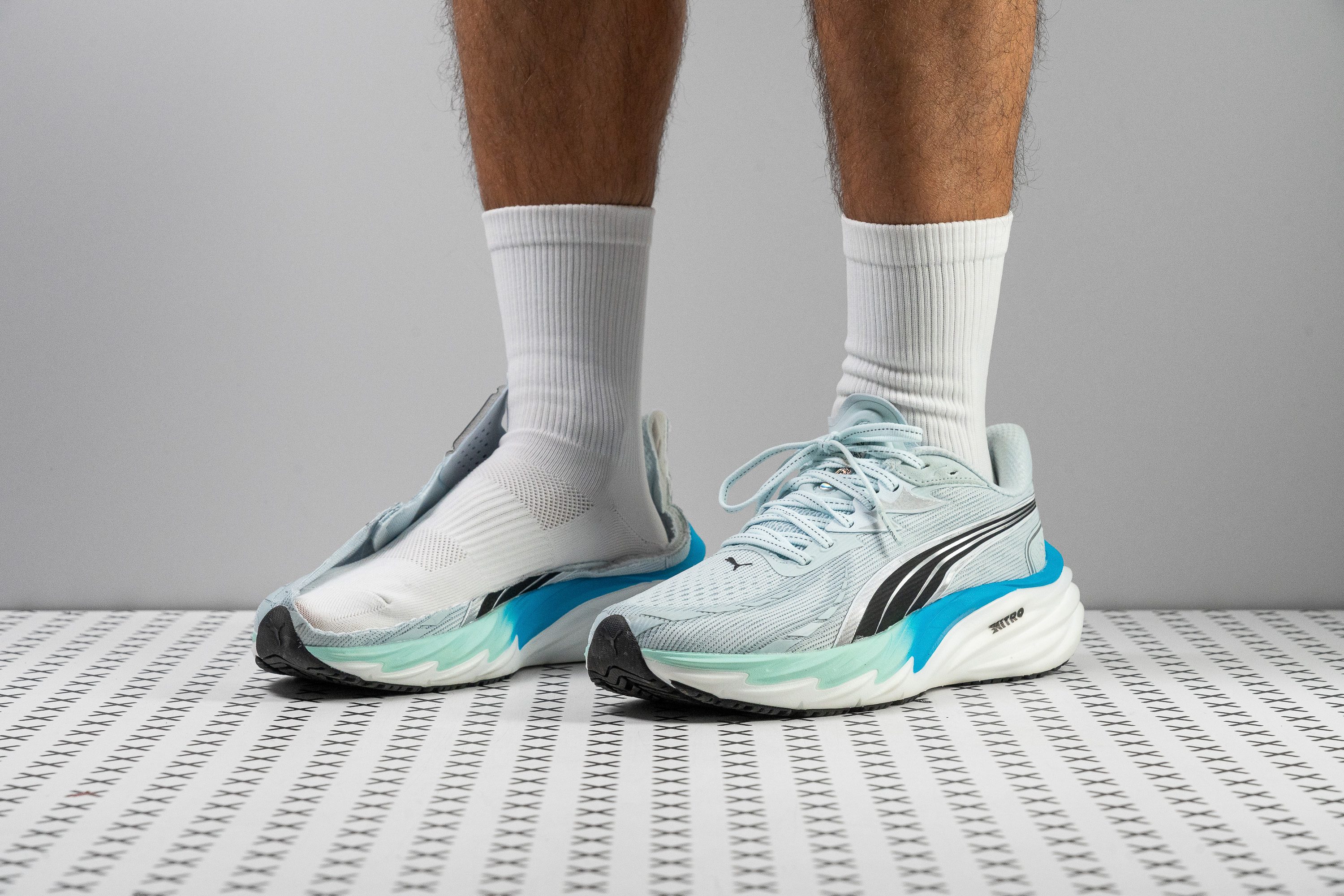












































What makes it the best?
The PUMA Velocity Nitro 4 is a plateless supertrainer that blew us away in our wear tests and lab analysis. It packs tons of cushioning and energy in its grounded and lightweight build, going against the trend of maximalist trainers nowadays. Its pliability makes it versatile for other workouts, making it our top flexible HYROX running shoe.
Weighing only 7.9 oz (224g) on our scale, Velocity Nitro 4 is 15.5% below the average running shoe. It feels easy on foot and boosts our agility during runs and other quick footwork exercises. It has a highly bendable build that offers the free movement we need for sled work and burpees. In our flex test, it emerged 41.1% more malleable than average, making it easy to maneuver and control.
We credit its lightness and flexibility to its low profile. Measuring 33.7/24.0 mm, it offers a feedback-rich and classic ride. Despite minimal foam, it surprisingly offers superior responsiveness and shock absorption.
The midsole feels bouncy and energetic, allowing us to shave off time during the 1-km run portions. Using our standardized test, the heel offers a remarkable 67.5% energy return, while the forefoot surprised us with its 74.2% score. Both performed better than the lab average, proving the shoe's responsiveness. With a solid shock absorption score of 136 SA in the heel, it’s able to reduce the forces of road running and repetitive jumping by 5.0% vs. average.
Note that the toebox area feels snug. We recommend those with broad or high-volume feet to try more accommodating trainers.
Pros
- Impressive energy return
- Lightweight and agile underfoot
- Superior traction from PumaGrip outsole
- Handles tempo efforts with ease
- Flexible and comfortable for everyday use
- Accurate real drop
- Natural-feeling, non-rockered design
- Balanced cushioning with some ground feel
- Looks really cool
Cons
- Not ideal for long runs
- Fit leans toward the narrow side
- Midsole becomes firmer in cold conditions
- Slight price increase
Best HYROX shoes for beginners
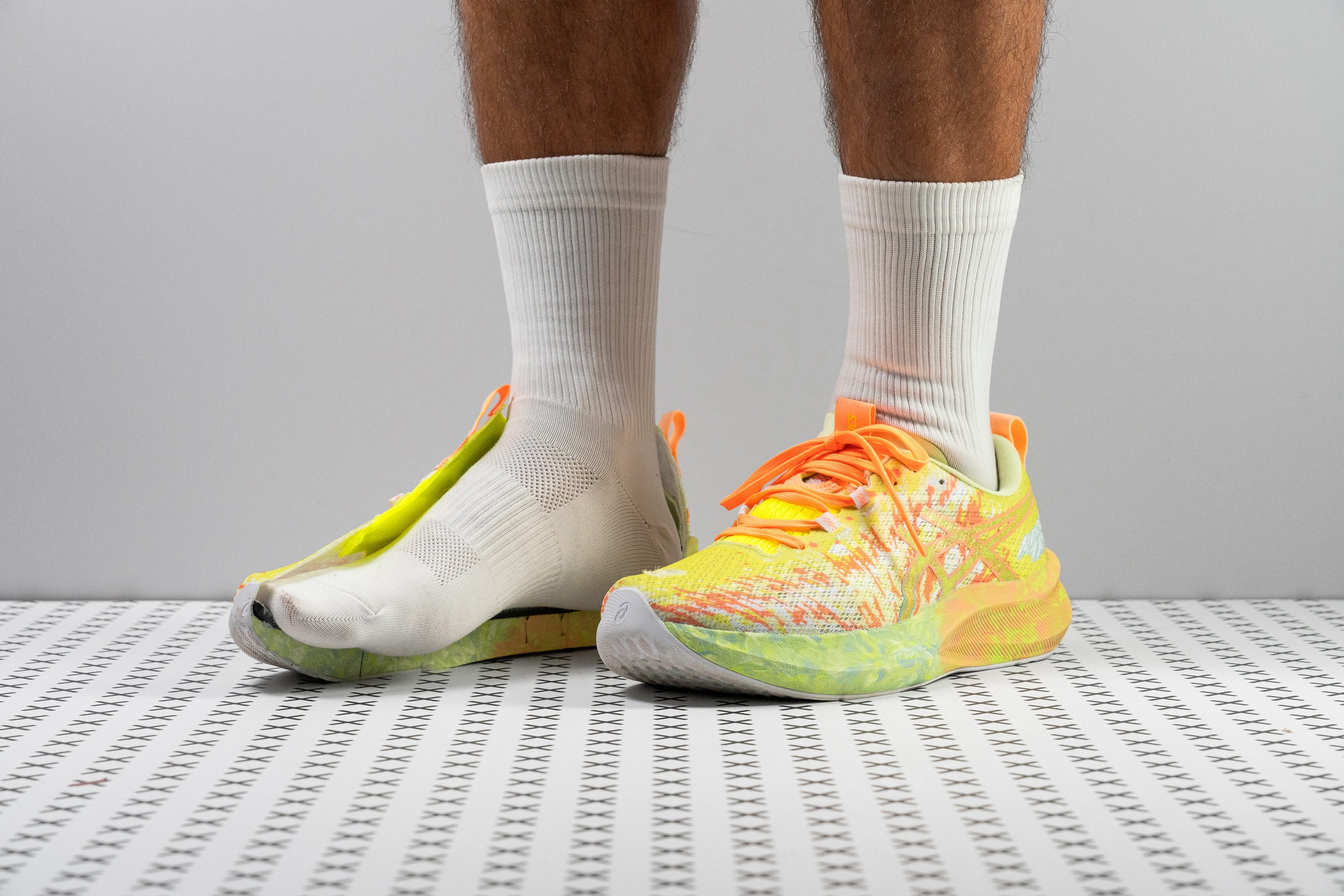





















































What makes it the best?
Weightless with every stride and flows with our feet, the ASICS Noosa Tri 16 is our top choice for beginners among HYROX running shoes. Besides its accessible $135 price tag, it offers solid traction and reliable support through its 3D Guidance System, which we discovered while testing further in the lab.
The Noosa Tri 16 is so easy to move in, defined by its light 7.7 oz (217g) build, 18.1% below average, and its flexible midsole. At par with average in our bend test, its malleability helps with movements like lunges and sled work. These features make the shoe feel natural and help us maintain good form by preventing the early onset of fatigue.
Underfoot, the outsole includes a central groove that enhances flexibility. We tested the forefoot’s traction on our machine and got a 0.79 score, making it 71.7% grippier than average, boosting our confidence when dealing with sweat-filled floors.
The 3D Guidance System also acts as a highly effective stabilizer through its midsole sidewalls and sole flare. It offers subtle support by preventing our feet from toppling over. We see the support it provides in the shoe’s high 4/5 torsional rigidity rating in our manual twist test.
However, it’s not the most energetic shoe out there. Those who prefer a high-performance shoe that will crush the 1-km run portions should go for a more responsive pair.
Pros
- Lightweight
- Exceptional grip
- Attention-grabbing aesthetic
- Gusseted tongue
- Comfortable upper
- Great for triathlon
- Really versatile
- Fantastic price point
- Breathability
Cons
- Upper longevity
- Minimal tongue padding
- Still not enough energy return
What makes a good HYROX shoe
The shoe choice for HYROX is complicated by the fact that this race combines running with functional fitness exercises. The two involve entirely different biomechanics and mutually exclusive shoe characteristics.
On the one hand, you need a fast, cushioned, and light shoe with great energy return to run the 1 km sprints in between each workstation (8 km in total). After all, the goal of the race is to complete the entire course as quickly as possible.
On the other hand, you need a stable and planted trainer with a super grippy outsole to be effective for movements in the RoxZone (SkiErg, sled pushes and pulls, burpee broad jumps, rowing, farmer’s carries, sandbag lunges, and wall balls).
|
It is hard to find a shoe that would be equally effective for both running and workstations. Some compromise is inevitable. Example: Choosing a speedy shoe with poor grip means that you win seconds when running but lose time spinning your wheels on sled pushes. |
The most acclaimed race running shoes (think Nike Alphafly) fail in functional fitness, while the most stable cross-trainers (like Nike Metcons) are a disaster for sprinting. But here is the good news – a lot of running shoes fall in the grey area between the two polarities, providing great grip and stability without sacrificing your running speed.
A more well-rounded shoe design will help you find a good balance here.
There is a good reason why the PUMA Deviate Nitro Elite 3 became the first official HYROX shoe. Okay, sure, the race is sponsored by PUMA, but aside from that, this is a good example of a versatile shoe that helps you run fast without feeling too wobbly and awkward at the stations.
A closer look at the PUMA Deviate reveals the following characteristics:
- Excellent outsole grip
- Stable and grounded platform
- Good energy return
- Decent forefoot flexibility
- Heel fits in the rowing machine
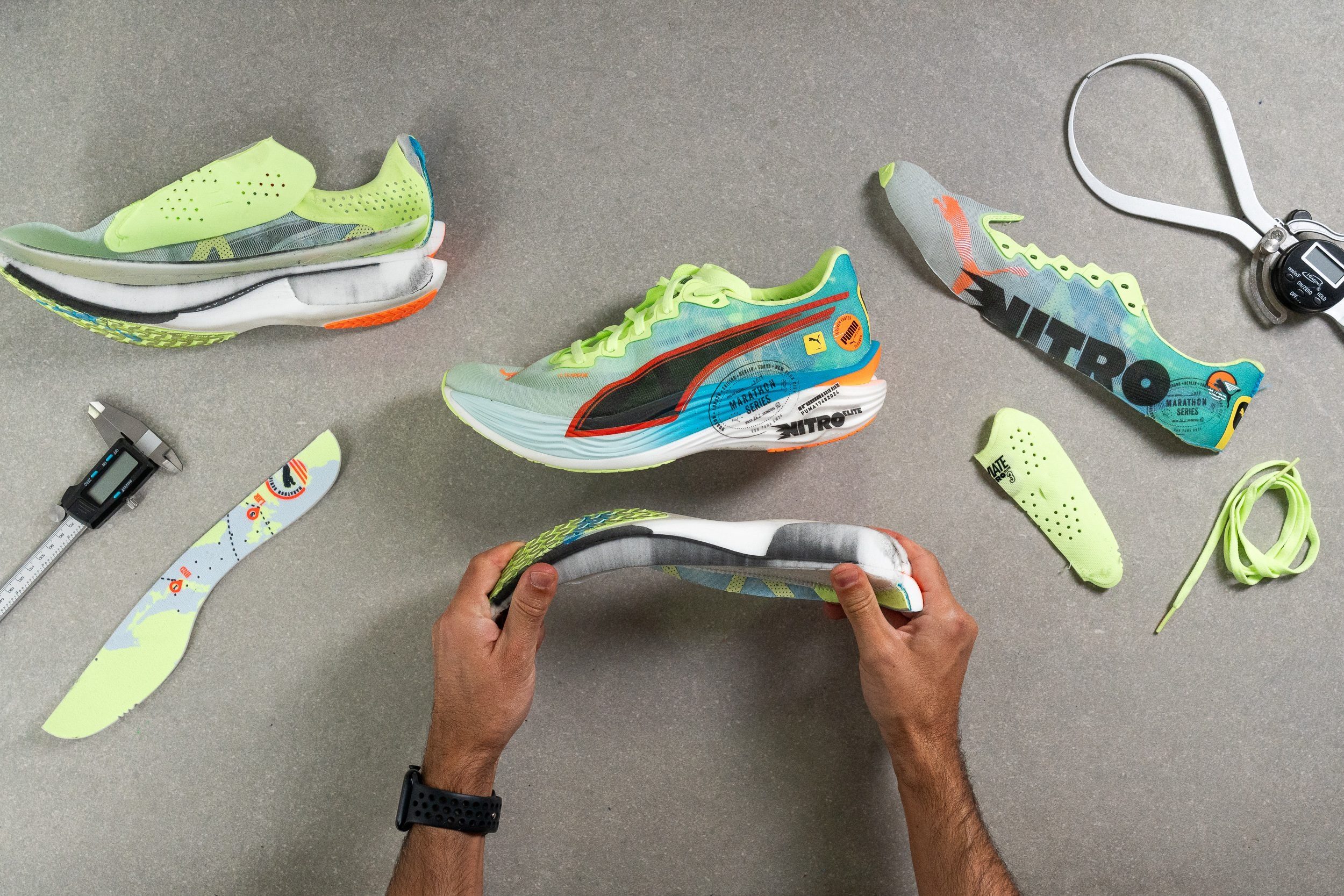
We believe that these shoe features are essential for any HYROX shoe if you want to remain stable and surefooted in the RoxZone and keep your best pace when running in between.
But given the individual needs and preferences, you might as well consider the following parameters:
- Heel-to-toe drop
- Arch support
- Heel lockdown
- Fit and toebox space
- Breathability
- Durability
- Weight
Wow, that’s a lot of boxes to tick!
But don’t worry, you don’t have to. You can choose which of these points are must-haves and which ones are optional for you.
| If your shoe feels comfortable, helps you perform your best, and prevents injury, it is the right HYROX shoe. |
Top 5 features to look for in the best HYROX shoes
If you are new to HYROX and don’t know where to start, we highly recommend checking if your shoes of choice have the five characteristics described in the sections below.
1. Excellent outsole grip
More specifically, grip on:
- Artificial carpet-style turf. Most functional fitness stations in HYROX are covered with a specifically designed turf surface called the Centr x HYROX Perform Turf.
- Polished concrete, smooth wood, or rubberized indoor track surfacing. Depending on the HYROX venue, these are the most common surfaces for running splits.
- Rubber flooring. Transition zones and some stations (wall balls, row, ski) are covered with rubber mats.
- Wet floor. It should also be noted that the venue flooring can get wet from sweat during the meet.
Most running shoes are designed for dry concrete roads and pavements and may not even have a full-length rubber outsole to provide the best grip on HYROX surfaces.
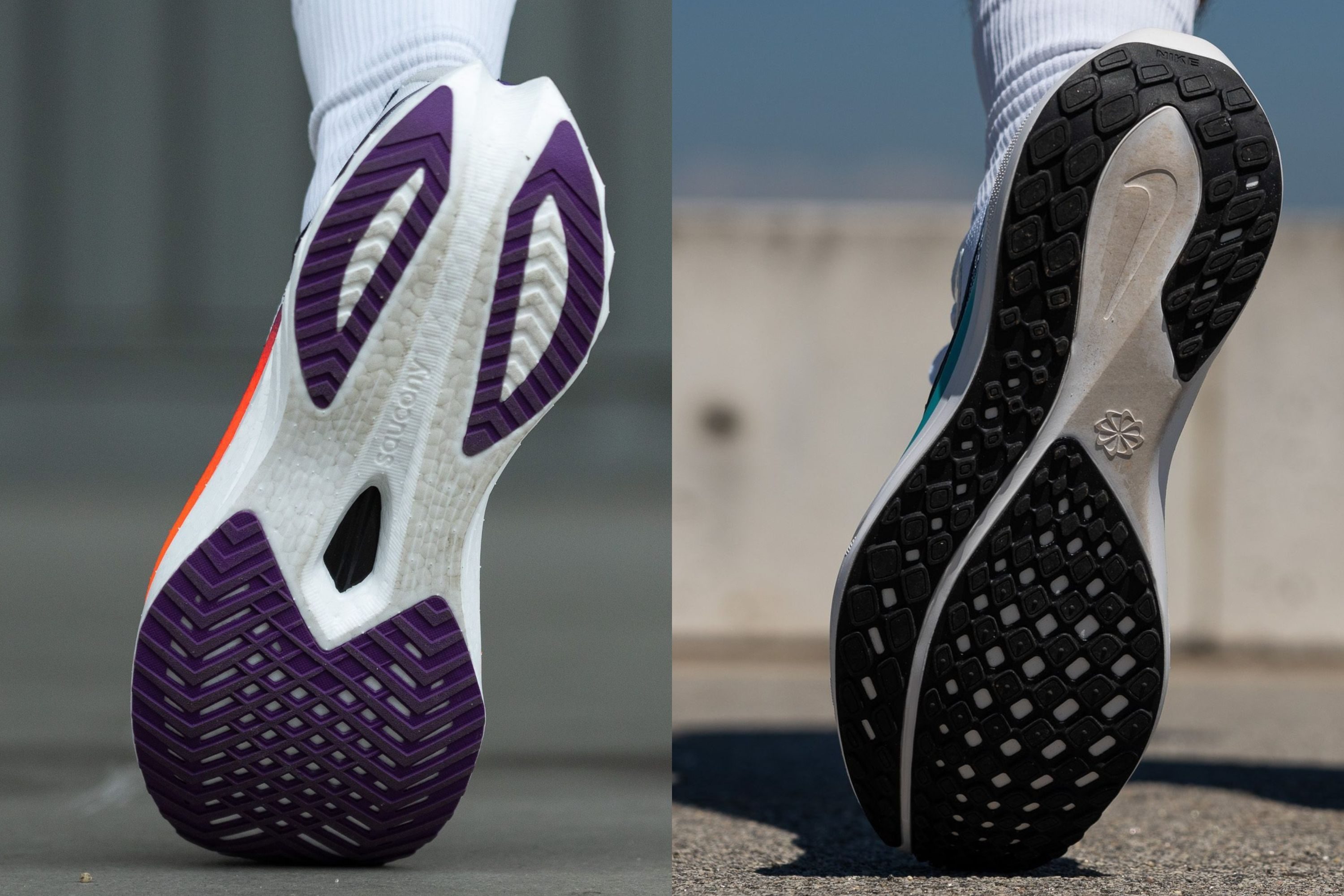
To give you an idea of how important grip is for HYROX, some Pro and Elite athletes even turn to trail running shoes for the benefit of higher traction! But we wouldn't recommend as deep lugs can hurt the foot on hard floors.
Sled pushes and pulls are where you need that grip the most in HYROX. Seasoned athletes all agree that this station can make or break your entire meet’s performance, so shoe choice is critical here. However, good traction is also helpful at the other stations, i.e. for safe landings from burpee broad jumps.
Slipping or losing your footing in HYROX means that you lose precious seconds of your time and, what’s even worse, put yourself at risk of getting injured.
So when you check the bottom of your future HYROX shoe, you want to see the following:
- Good rubber coverage (specifically in the ball of the foot area)
- Some defined texture or even shallow lugs on the rubber
- High outsole friction
We follow an acclaimed SATRA TM144 method for testing each shoe’s outsole grip to let you know its coefficient of friction (CoF).
Here is an overview of HYROX shoes with the best forefoot traction, according to our lab tests. The higher the number (CoF), the better the grip:
2. Stable and grounded platform
Running shoes are designed for linear forward movement and propulsion. Who would’ve thought that people would start shuttling heavy kettlebells in them?
But gladly, there are running shoes with decently stable platforms that provide sufficient stability and power transfer for the RoxZone. You can recognize them by the following features:
- Moderate stack height
- Moderately soft or firm cushioning
- Decently wide base
We highly recommend choosing HYROX shoes with a heel stack of 30-38 mm. This setup provides enough cushioning without making you feel too disconnected from the ground or compromising stability.
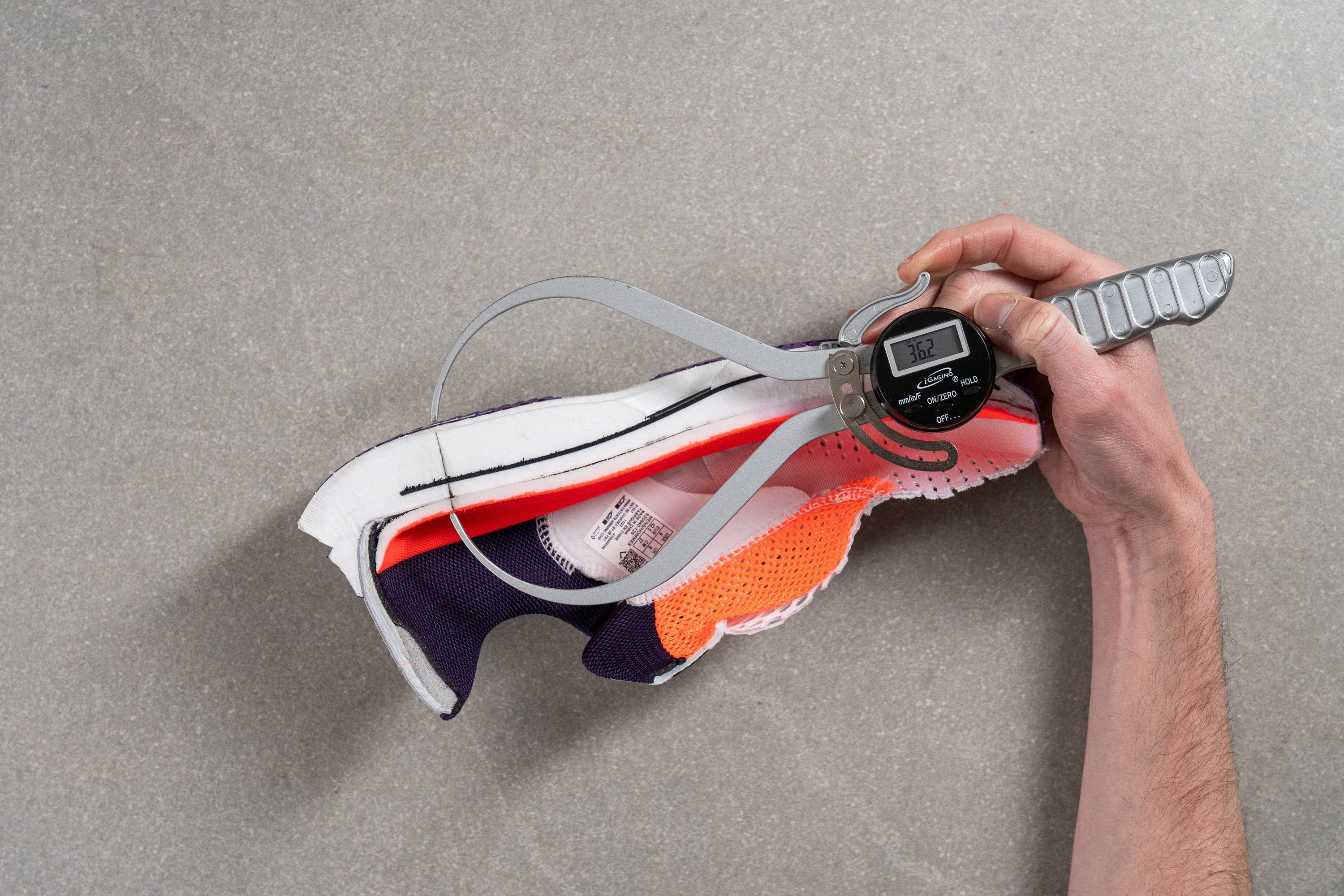
The HYROX competition rules don't put any cap on the shoe’s stack height, but choosing shoes with a 40+ mm heel stack comes with a price, as you are:
- sacrificing stability at the weighted stations
- raising your chances of getting injured
- making it harder for some reps to count (i.e., sandbag lunges only count if your knee makes contact with the ground, which can be harder to do on a taller platform)
- potentially losing seconds fitting your thick-foamed shoe into the rower’s heel cup
A higher heel stack almost always implies a higher forefoot stack. Please note that shoes with a forefoot stack of 30+ mm also make it nearly impossible to bend the foot in the forefoot (especially if there is a carbon plate involved). This can be a major hindrance when doing burpees and lunges.
Weighted stations like Farmer’s carries, sandbag lunges, and rowing machines call for firmer and less compressible soles for better output. Mushy and spongy foams will result in instability and muted energy transfer.
Example of a HYROX shoe with moderate cushioning softness (22 HA)
We cut shoes in half and use a Shore A durometer to measure the softness of their midsole foams. The lower the HA reading, the softer the foam: 0-20 HA = soft, 20-30 HA = balanced, 30+ HA = firm.
We measure both primary and secondary foams (if any) because some shoes can mix plush compounds for shock absorption and firmer ones for stability.
In our experience, running shoes with a midsole firmness of at least 15 HA could be recommended for HYROX.

Here is an overview of midsole softness in the most popular HYROX shoes. The higher the HA number, the firmer the sole:
Underfoot stability also comes from shoes with a wider platform (at least 80 mm in the widest part of the heel).
Having extended contact points with the ground helps you stay planted and surefooted at the workstations and sharp turns, especially closer to the finish line when leg fatigue kicks in.

3. Good energy return
Super shoes entice HYROX athletes with their advanced PEBA (or other supercritical foam) and carbon (or nylon plates), which provide exceptional energy return during the running splits of HYROX.
Yes, these shoes feel notably bouncier and make toe-offs feel extra springy and propelling. But do you necessarily need a super shoe (or a carbon-plated shoe for that matter) to compete in HYROX? Not at all!
In fact, race shoes can get in the way of your performance at the stations because they lack the needed stability and flexibility.
Given the shorter distance of running splits (1 km) and the total running distance (8 km), you can choose any running shoe that you would otherwise pick for a 5K/or 10K race.
Ideally, you would want a mix of good energy return and stability for the workstations. But if you want an edge in speed and hope to shave some seconds off your PB, you are better off with shoes that show the highest percentage of energy return (60% or more).
We use specialized equipment and follow the industry’s ASTM F1976-13 standard to measure the precise energy return (%) of all shoes in our lab.
4. Decent forefoot flexibility
The shoe's forefoot flexibility is yet another area for a compromise in HYROX shoes.
On the one hand, you want a stiffer and more propulsive springboard effect to keep you fast on your feet during the running splits. But on the other hand, you need some decent pliability to perform sled pushes, burpees, and sandbag lunges.
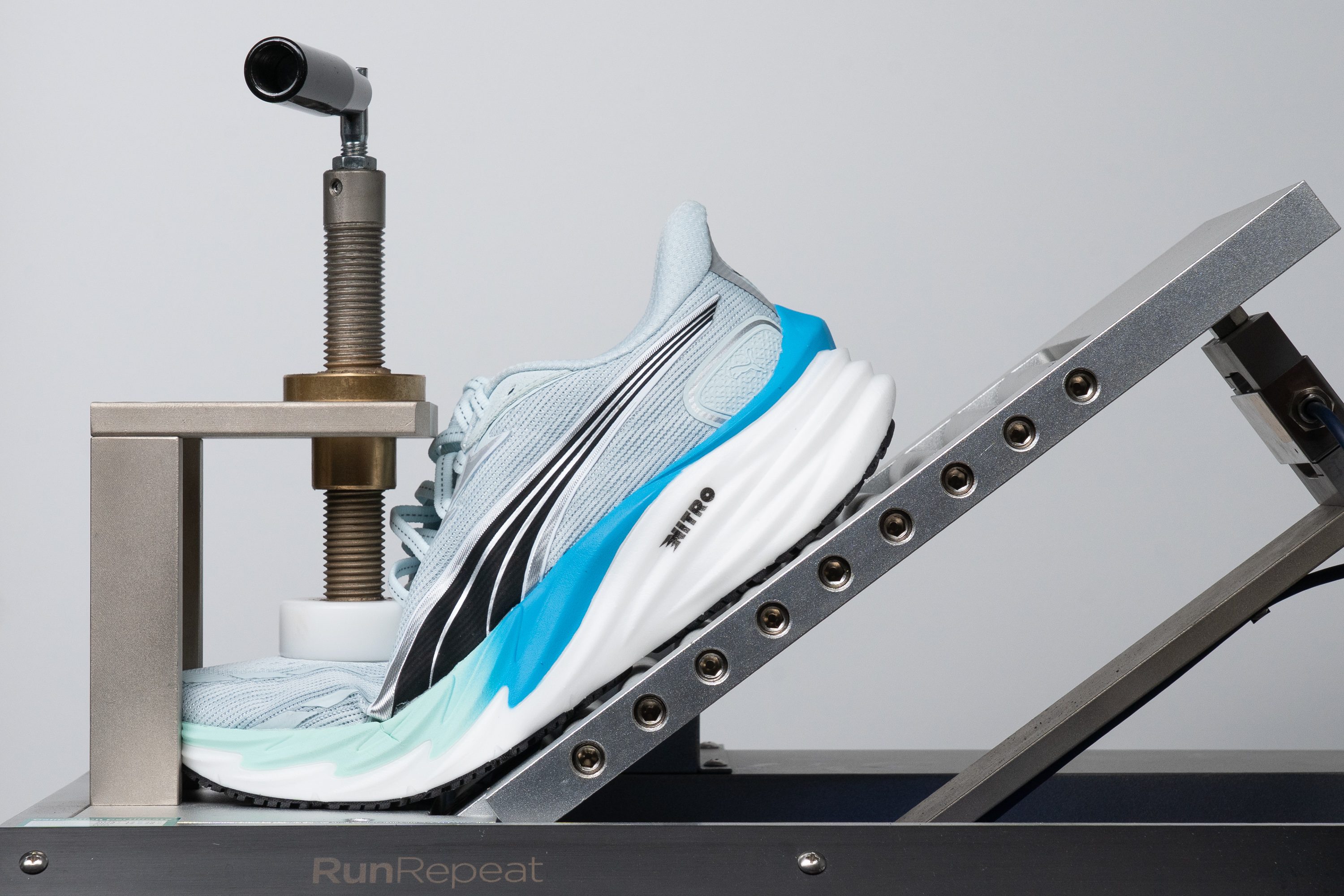
The average forefoot flexibility of HYROX shoes hovers around 13N, which is a perfectly balanced setup for this competition, in our opinion. However, some popular carbon-plated models reach as much as 25N, which can be too rigid for some athletes.
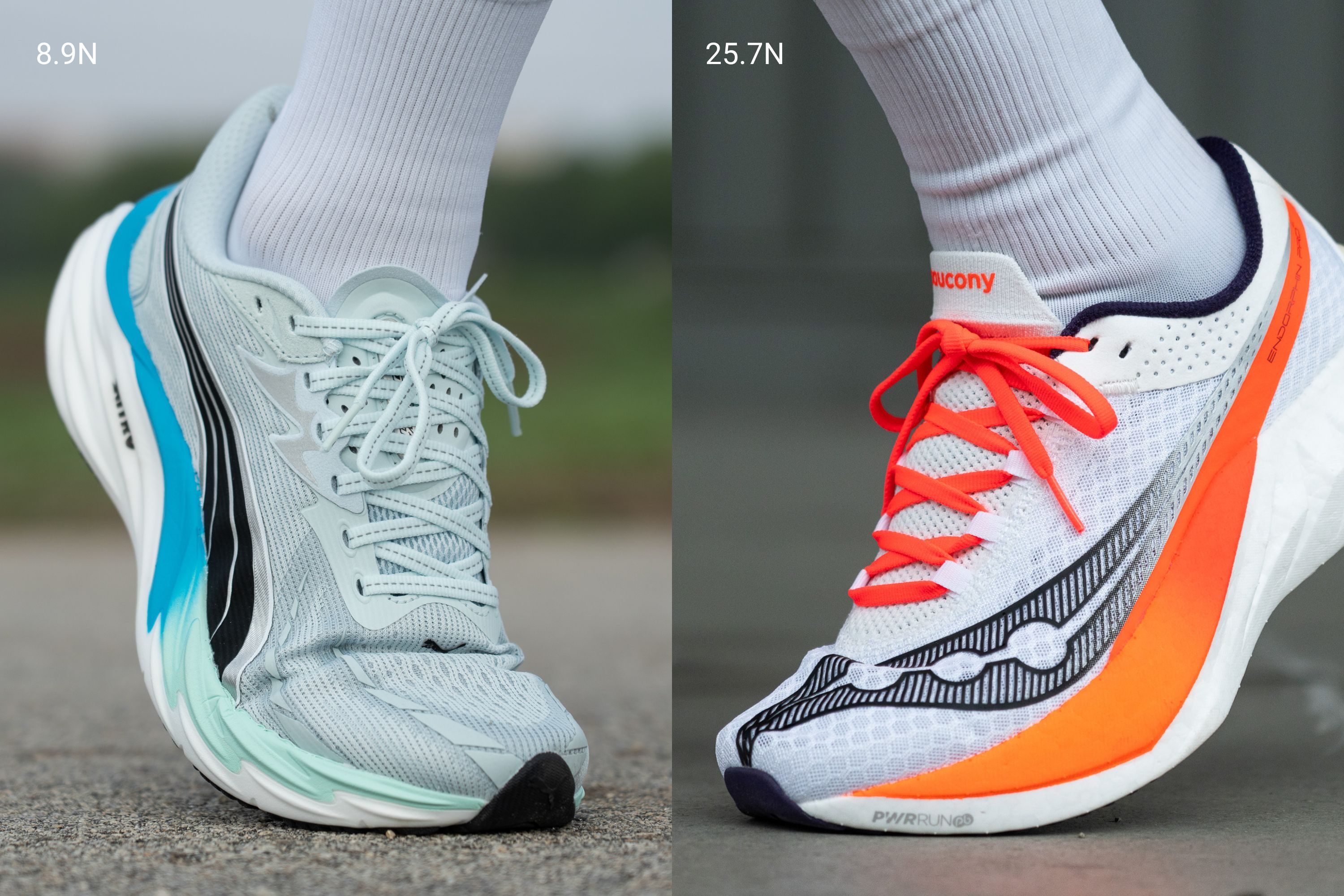
5. Heel shape
Because one of the HYROX stations involves a rowing machine, you want to choose shoes with a more traditional, rounded heel shape.
Stay away from shoes with unconventional heel designs or protruding (flared) elements that don’t fit into the Concept2 rower heel cups.

Other important things to consider in HYROX shoes
In our opinion, grip, platform stability, and energy return are the most crucial characteristics of a HYROX shoe.
However, depending on your personal needs and preferences, you may find other shoe characteristics just as important:
- Say you have wide feet and need a roomy toebox?
- Or you need more arch support for flat feet and overpronation?
- Or maybe you want the most breathable shoe ever known to mankind?
Let’s dive into these nitty-gritties and fine-tune the perfect HYROX shoe for you.
Heel-to-toe drop
The difference in stack heights between the shoe’s heel and forefoot is referred to as the drop. The higher the drop, the higher your heel sits above the toes inside the shoe.
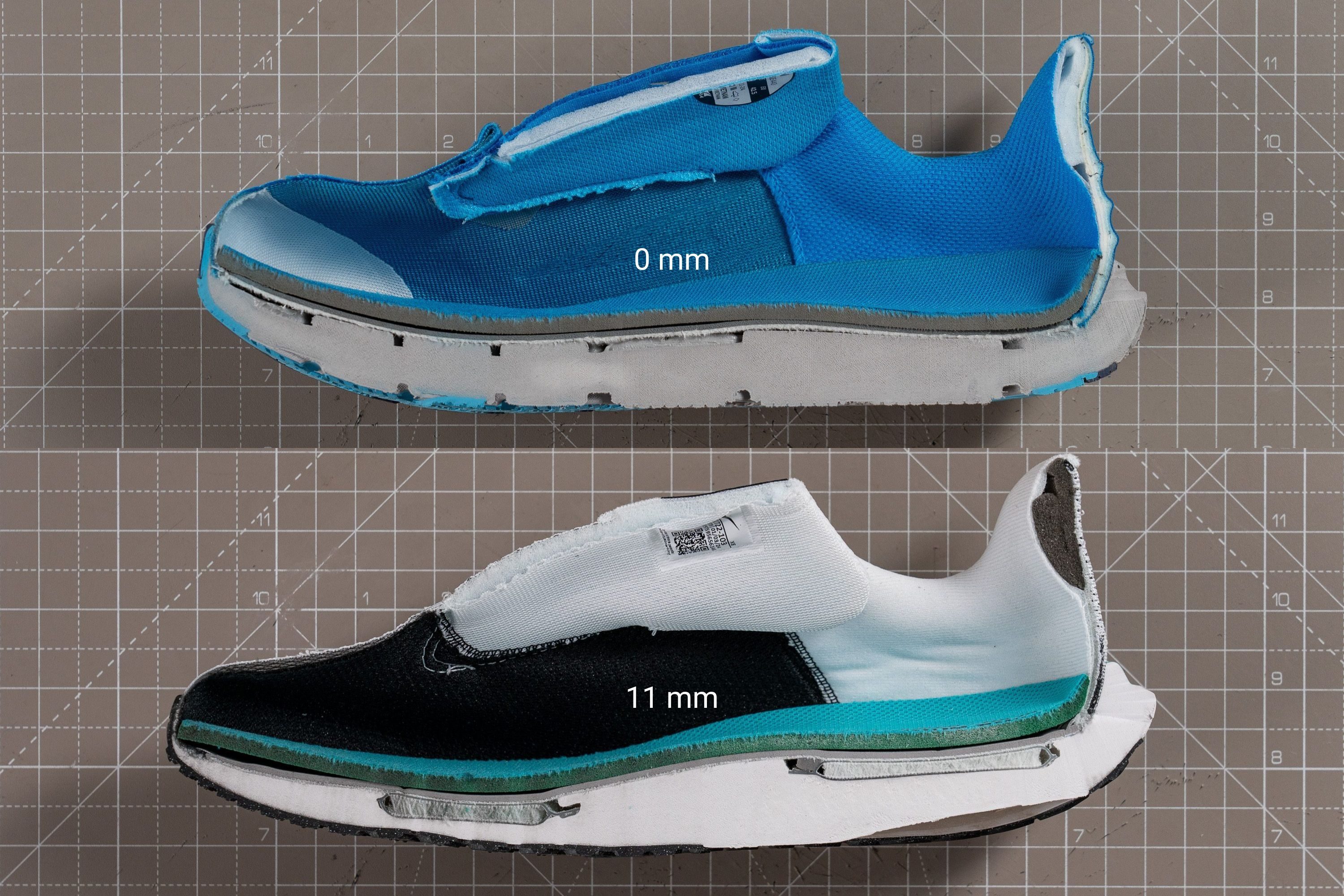
The most common heel-to-toe drop in running shoes is 8-10 mm, but you can also find some low-drop options (less than 4.5 mm) and even zero-drop shoes.
When choosing the right heel-to-toe offset for you, consider the following:
-
Your strike pattern for running: High drop is better for heel strikers while low-to-zero drop caters to forefoot strikers. For more nuances, see our comprehensive guide on the heel-to-toe drop in running shoes.
-
Your ankle mobility for squats: High drop is better for poor ankle mobility because a wall ball rep only counts when your thighs are parallel with the ground.
|
If you are a beginner HYROX participant, we recommend choosing shoes with a standard drop of at least 6 mm. |
Arch support
If you have a case of flat feet (or low arches) paired with moderate or severe overpronation, your HYROX shoe must have proper arch support as well.
Based on the level of arch support they provide, all running shoes are divided into neutral and stability categories. Here is a quick overview of pronation types and the shoe types recommended for them:

Unfortunately, the choice of stability shoes for HYROX is quite limited, so athletes with overpronation may opt for neutral shoes with higher torsional rigidity, as well as firmer and wider midsoles to support their biomechanics.
Heel lockdown
A good HYROX shoe will provide a comfortably snug and secure rearfoot experience, minimizing the risk of heel slippage and ankle wobbling. This is especially important for sled pushes when you are exerting force on your tiptoes.
If you are a beginner, choose shoes with moderately stiff and padded heel counters as they provide a good amount of rearfoot support and lockdown. An extra pair of eyelets may come in handy as well if you use a heel lock lacing for a more secure fit.
We check each shoe’s heel counter stiffness manually with a push-and-squeeze test and rate it on a 1-5 stiffness scale (5 being the stiffest).
TIP: Choose more flexible heel counters if you have sensitive Achilles and stiffer ones if you have moderate-to-severe overpronation (to prevent excessive inward rolling of the foot).
Fit and toebox space
HYROX races keep you on your feet for a good 90 minutes straight, so you better be wearing a well-fitting pair of shoes!
In addition to the snug heel fit discussed above, your HYROX shoe must accommodate your foot shape without any hot spots or pressure points.
There are a few things you want to consider when looking for a perfect fit on a HYROX shoe:
Size (shoe length): Knowing your current foot length will help you get the right shoe length and fit in the first place. Studies show that up to 60-70% of people are wearing shoes that are too small or too tight!
Fit (shoe width): Shoe width varies greatly, even in a standard D medium width. Our lab tests show that the widest part of the shoe’s upper (ball of foot area) ranges from 90 to 100+ mm! Athletes with wider feet should either opt for a wider-fitting medium-width shoe or consider an alternative wide/extra wide width (not available in all shoes, unfortunately).
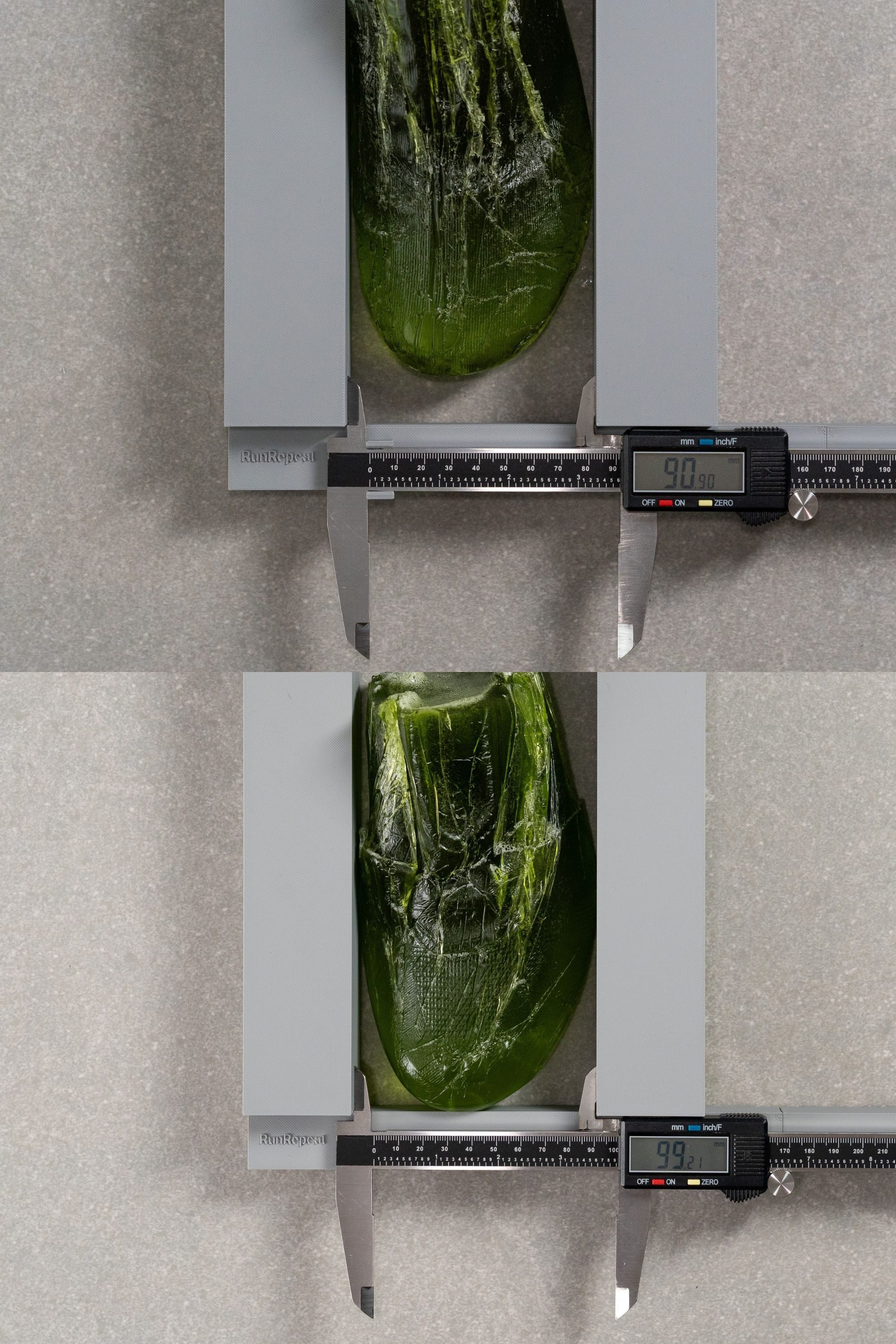
Toebox width: Shoe toeboxes come in all shapes and sizes, from narrow and pointy to rounded and spacious (from 70 to 80+ mm). We measure the width of each shoe’s toebox in the big toe area to let you know how much toe space to expect.
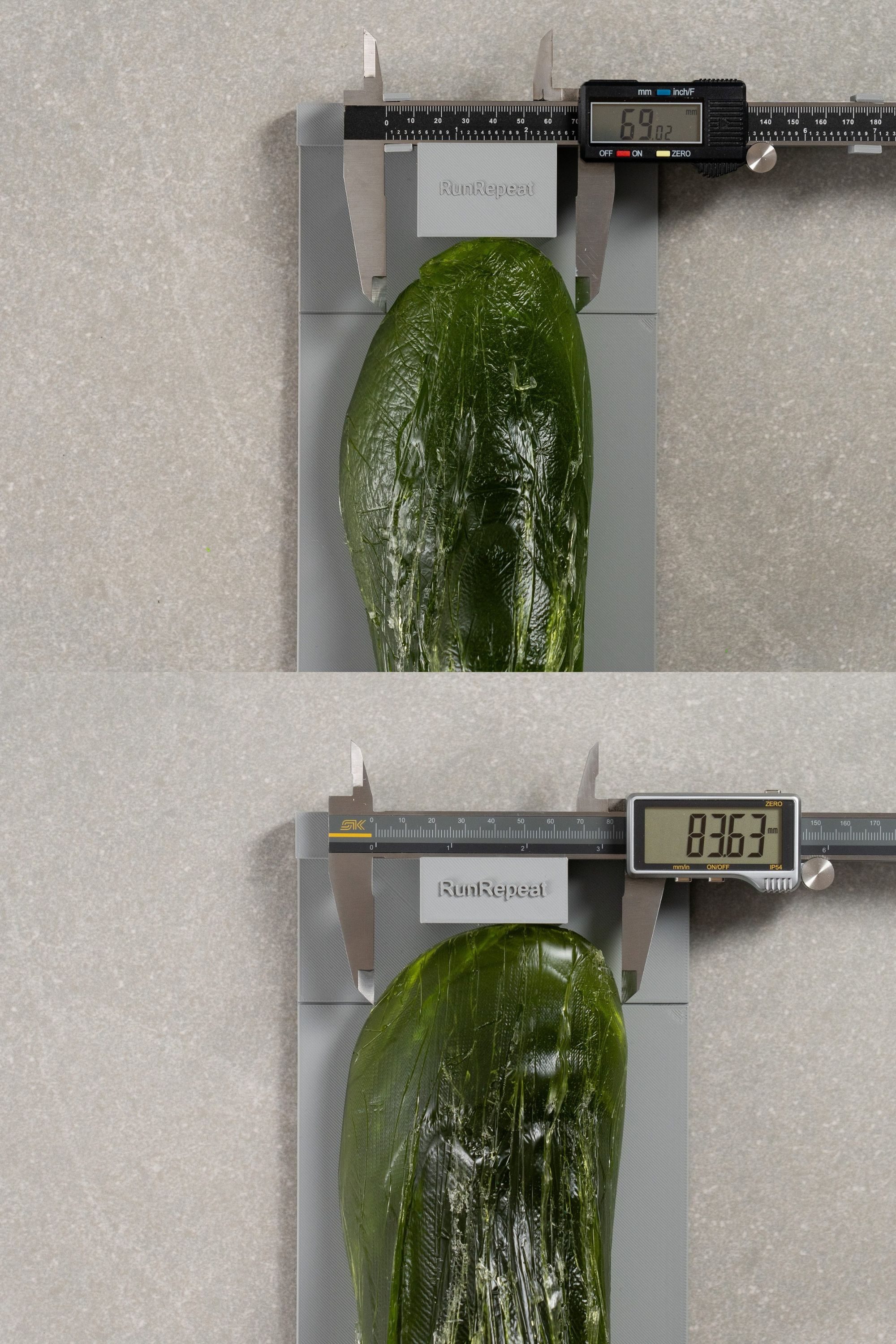
Toebox height: Measuring the toebox height of all tested shoes, we found that some uppers sit extra close to your toes (23 mm), while others leave plenty of vertical space above them (33 mm). This is especially important to know for people with black or ingrown toenails, hammer toes, and similar toe deformations.
Breathability
Maintaining your peak performance for up to 90 minutes generates a ton of heat and sweat inside the shoes!
This not only affects comfort but can also result in foot swelling, blisters, or, worse, foot slipping inside the shoe which compromises control during sled pushes, burpee broad jumps, and other exercises.
Choosing shoes with breathable mesh uppers and perforations helps to regulate the in-shoe temperature and airflow.
We test each shoe’s breathability using a smoke-pumping machine, a LED light, and even a microscope. In the end, each shoe gets a 1-5 breathability score.
Durability
Running shoe designers didn’t necessarily imagine that their products would be used for sled pushes or burpees on rough carpeted turf.
If you want your pair of HYROX shoes to last a little longer than a few training sessions and a race, it makes sense to check their durability in the following areas:
Outsole durability: When the outsole starts to show signs of wear and tear, it also loses the initial grip it offered. To test how well each shoe’s outsole rubber stands up against abrasion, we take it through our Dremel and sandpaper test. The shallower the damage, the better the durability.
Toebox durability: The exposed mesh uppers of running shoes weren’t meant for high-impact slashes against rough floors either. Buprees and sandbag lunges can cause some serious tears in the upper material, but we are here to assess each HYROX shoe’s toebox on a 1-5 durability scale.
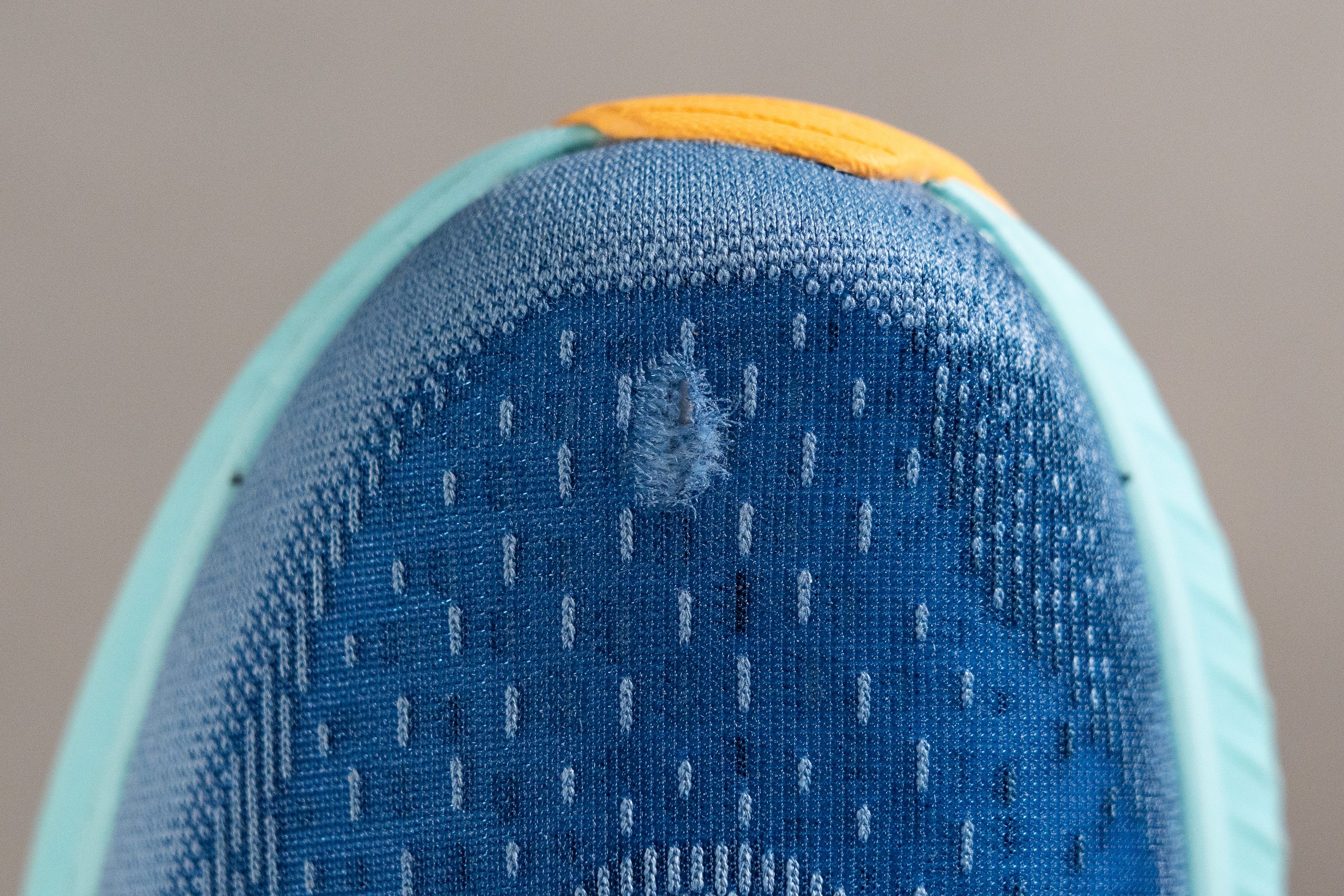
Heel padding durability: Sled pushes, lunges, and wall balls all cause more friction in the collar area than regular running. That’s why we also apply our Dremel test to the lining inside each shoe’s heel collar.
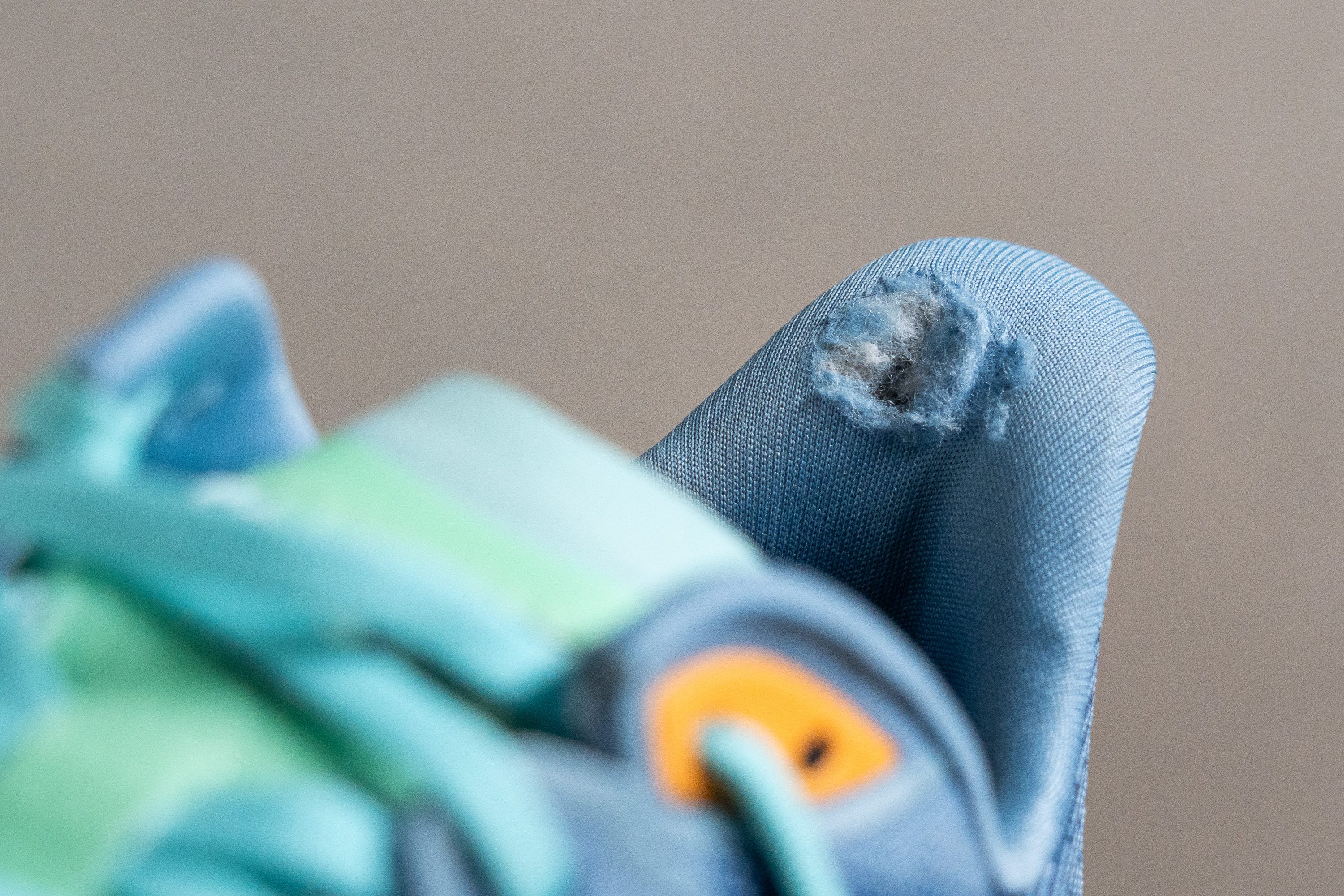
Weight
Because every second of your finish time counts in HYROX, it makes sense to choose a lighter shoe to help you be faster, save energy, and feel more nimble on your feet in the RoxZone.
However, shaving grams off your HYROX shoe may not be worth it if that means sacrificing other essential parameters like grip (lighter shoes may lack a grippy rubber outsole) or stability (lighter shoes can be narrower and shakier).
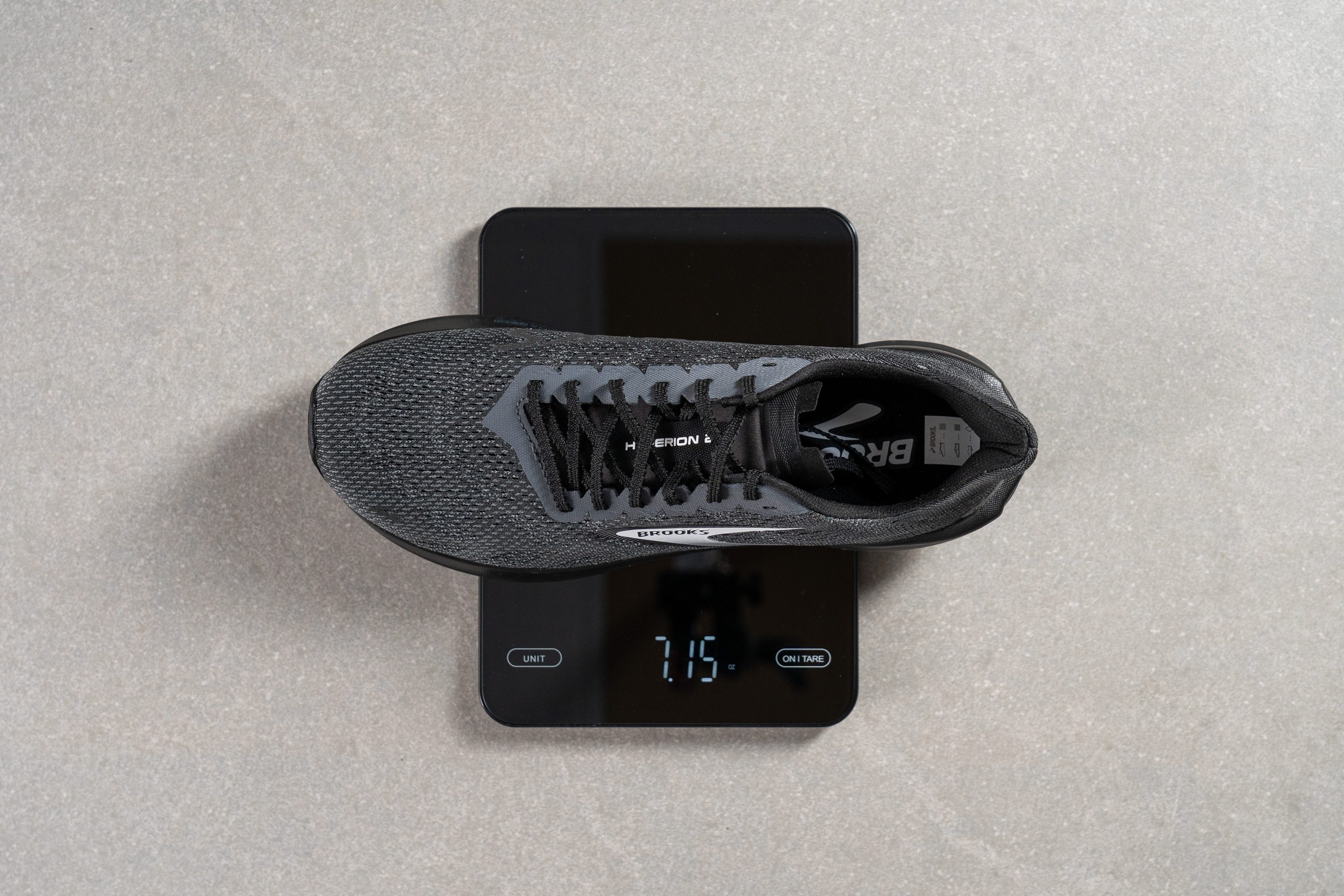
Ideally, you want to choose the lightest option among the HYROX shoes that meet your needs in all the characteristics we discussed in this guide.

